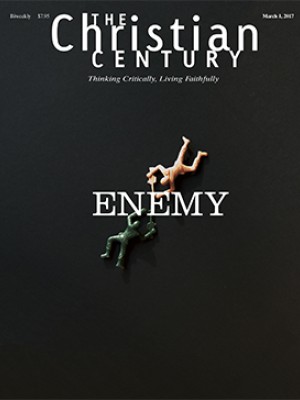My church and its two different Lents
Our lives are overstuffed, and we desperately need to fast.
On the eighth day of Christmas, I began my diet. Or rather, I embarked upon a penitential period of prayer and fasting—but it sure better involve my losing weight. This regime is in accordance with an official, corporate season in my local church. We habitually start the new year with 40 days of prayer and fasting. The church staff even sends out an e-mail each morning with suggestions as to what the faithful should pray for that day.
My church’s founder and senior minister learned this practice during his apprenticeship at a Pentecostal church that was part of the Assemblies of God. Our church is loosely associated with the AG as well. Thus, I have come to think of this time of fasting as a season called Pentecostal Lent.
Read our latest issue or browse back issues.
Our minister was deeply influenced by theologian Robert E. Webber, founder of the Institute for Worship Studies. Webber promoted “blend worship,” by which he meant primarily a way to encourage churches that had thoroughly adopted a contemporary worship style to incorporate elements of historic liturgical practice.
We also follow the church year. Admittedly, this is not a habitual way of life for us so much as a conscious attempt to incorporate what is not very familiar. More than once on the first Sunday of Lent, a minister has announced sheepishly, “Well, it turns out last Wednesday was Ash Wednesday.” Some years nobody thinks to procure palms for Palm Sunday until it’s too late.
For a while I attended a mainline Congregational church that had rebranded Lent as “the Season of the Cross.” I found this change helpful—it’s a more readily explicable and meaningful name—and I have tried to introduce it at my current church. But these heartland Pentecostals are determined to call it Lent. Moreover, as the season unfolds, we “do the stuff,” to adopt a favorite phrase of John Wimber, a leader in the charismatic movement: from the imposition of ashes right through to the stations of the cross.
The blend is not always well suited. In January and February, I am sharply reminded of how close Pentecostal Lent is to traditional Lent. In years when Easter comes early, the two Lents actually overlap. One might have to kiss chocolate good-bye from New Year’s Eve all the way to Easter morning.
I first tried to observe Lent when I was about 20 years old—also, as it happens, partially under the spell of the effervescent Robert Webber. I remember how impossibly long the season seemed. One would start into the discipline with such zeal and high hopes for personal transformation, but the novelty wore off long before anyone was calling upon you to proclaim, “He has risen indeed!” One year, I gave up all processed sugar for Lent. My tacit but (crucially) unavowed assumption was that this meant no desserts. A couple weeks in, however, indiscipline became the mother of invention, and I figured out a loophole. Thereafter, I could have set up my own Greek bakery, making baklava daily with copious amounts of honey.
As I get older, time moves faster. One fringe benefit of this well-known experience is that Lent goes by much faster as well.
Lots of low-church Protestants claim not to follow the church year, but they still observe Christmas and Easter. I tend to tease them that what they have actually done is cherry-picked the best feasts while throwing out all the fasts. For this reason, I have come to value the eccentric tradition of squeezing Pentecostal Lent into a traditional church year. It has the important advantage of adding some more fasting into my life. This is a discipline I desperately need—not just because my weight has been creeping up again, but because my life is overstuffed in every way, clogged with the excess fat of my selfish ambitions and vain conceits.
In the church where I grew up, if people fasted it was almost always a disciplina arcani undertaken without reference to the rest of the congregation. Christ’s admonition to fast in a way that does not draw attention to the practice loomed large in our minds. This had the ironic effect of putting the emphasis on ourselves as a kind of spiritual superhero incognito. To try to hide the fast and then get found out anyway became a delicious dance of spiritual pride. Yes, I am free on Friday. No, I cannot have lunch.
So a great strength of the church year is that we are all in it together. I am not pursuing some spiritual extreme sport; I am just muddling through with everyone else, trying to keep in step with the Spirit in this season we share. Like Lent itself, Pentecostal Lent is another occasion to bring fasting, which I emphatically need, into my life—as part of simply being an ordinary church member, keeping time, trying to clap along with everyone else to a chorus someone else chose.
And in any case, Pentecostal Lent presents a pretty good trade-off. Purists tell me that Advent is supposed to be a penitential season as well, and I am certainly not going to try to incorporate that discipline. I find it impossible to imagine spending December going from party to party and gathering to gathering and simply nibbling some carrot sticks from the holiday buffet, while quietly searching my heart against a checklist of the Ten Commandments or the seven deadly sins.
But if you’re not going to fast during Advent, then you probably shouldn’t feast your way through the full 12 days of Christmas, either. It is often true that even before December arrives, “we need a little Christmas, right this very minute.” By the first week of January, I feel the same way about Lent.
A version of this article appears in the March 1 print edition under the title “The fasts we choose.”







